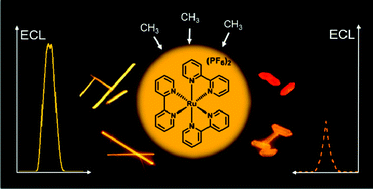Molecular engineering towards tunable morphology of metal–organic complex microcrystals for efficient and multicolor electrochemiluminescence†
Abstract
Electrochemiluminescence (ECL) of crystalline materials has recently attracted increasing attention due to their unique characteristics and applications, such as crystallization-induced emission, active waveguiding, and biosensing. Tris(2,2′-bipyridine)ruthenium(II), [Ru(bpy)3]2+, a classical metal–organic complex for ECL studies, has been fully investigated in solution as well as its derivatives. However, the dependence of ECL properties on the molecular structure and crystal morphology of these complexes has not been illustrated, partially due to the difficulty in the controlled crystal growth. Here, we adopt a facile molecular engineering strategy to obtain microcrystals of [Ru(bpy)3]2+ derivatives with well-defined morphology (rods, wires, or polyhedrons) and varied phosphorescence emission colors (yellow, orange, and red) by simply changing the position and number of methyl substituents on the bipyridine ligands. The packing modes of molecules influenced by methyl groups play a vital role in crystal growth based on attachment energy analysis. The obtained microcrystals could act as ECL luminophores when modified on glassy carbon electrode surfaces. Those with one-dimensional (1D) morphology generally show superior ECL efficiency and stability to three-dimensional (3D) shaped microcrystals. ECL biosensors made of stable 1D microcrystals show reliable and sensitive responses to hydroxyproline, demonstrating their capacity in recyclable detections. This work demonstrates the great potential of molecular engineering in controlling the morphology, emission colors, and ECL properties of molecular crystals, paving the way for the development of high-performance ECL biosensing and optoelectronic devices.



 Please wait while we load your content...
Please wait while we load your content...